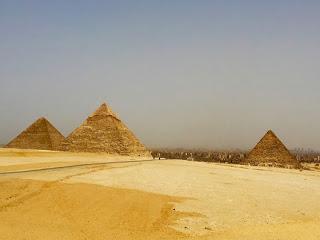 It seems the discoveries just keep coming in Egypt, a civilization thousands of years old with plenty of monuments to prove it. Researchers in Cairo now say that they have discovered "cavities" inside one of the most well known and iconic structures on Earth – the Great Pyramid itself.
It seems the discoveries just keep coming in Egypt, a civilization thousands of years old with plenty of monuments to prove it. Researchers in Cairo now say that they have discovered "cavities" inside one of the most well known and iconic structures on Earth – the Great Pyramid itself.The discovery was made using imaging technology called muography. This technique uses special equipment to analyze radioactive particles known as muons. Analysts can detect where the particles are most dense or least dense to help create an image of the interior of spaces. In this way, it works much like ground penetrating radar, providing a map of the interior of the pyramid itself.
According to reports, the team conducting the study says that they are "now able to confirm the existence of a ‘void’ hidden behind the North Face, that could have the form of at least one corridor going inside the Great Pyramid.” The team added that “The precise shape, size, and exact position of this void is now under further investigation. It should be done with the help of 12 new Muon Emulsion plates that are installed in the descending corridor, and will be collected by the end of October 2016.”
The same researchers say that they have also located a second "void" in the structure that is located behind the descending corridor inside the pyramid as well. This corridor is the one that leads directly down into the structure to the tomb of the pharaoh Khufu, who had the pyramid constructed as his burial chamber some 4500 years ago.
What does all of this mean? We'll just have to wait for further information to know for sure, but it could confirm the existence of hidden chambers inside the Great Pyramid. What those chambers could contain would be open to speculation of course, but anyone who has ever been inside these structures can tell you that they are unimpressive other than from an architectural/construction sense. Unlike the tombs in the Valley of the Kings and Queens, the walls are not covered in hieroglyphs or painted in ornamental styles. Instead, they are bare, smooth, and colorless. The corridor and chambers are relatively small, and even a bit claustrophobic. But, it is possible that important items for Khufu were stashed in these spaces to prevent them from being looted by thieves.
Of course, it is also hard to get too excited about these "discoveries" considering the hype that was made last year about possibly finding the tomb of Nefertiti hidden inside that of the boy-king Tut. Those claims later seemed to have been proved false, although archaeologists continue to research the findings. Will this be a similar story? If these chambers inside the Pyramid are real, will they hold anything of value? Or are they just part of how the structure was made? It will likely be months before we know for sure, but it is definitely intriguing to think about.

